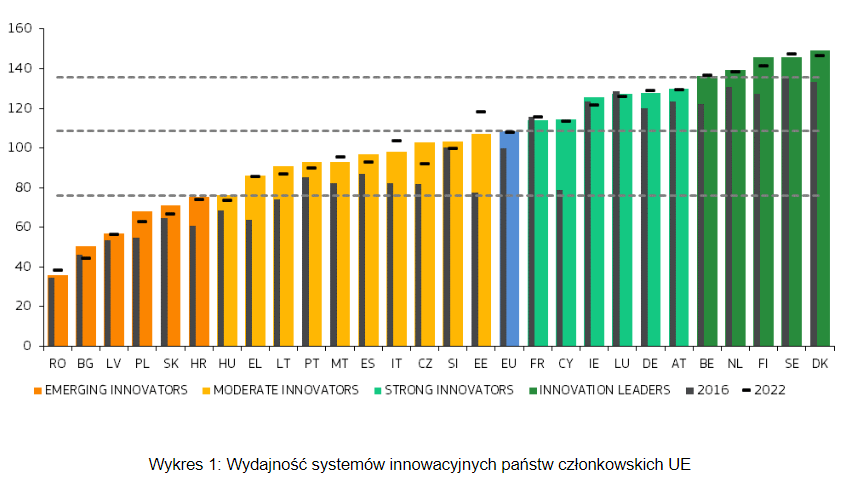Denmark ranked the top European innovator, with Poland faring well behind, according to the European Innovation Scoreboard 2023. Poland has narrowed some gaps, but it still has a long way to go to catch up with the EU.
The European Commission has released the European Innovation Scoreboard 2023 and the Regional Innovation Scoreboard. Despite the numerous crises faced by Europe, EU Member States continue to improve their innovation performance. According to the report, the EU’s innovation performance has increased by 8.5 percentage points despite the difficulties.
Innovation levels have gone up significantly in 25 Member States, while 20 Member States have experienced a significant increase in their innovation capacity. The remaining seven Member States have seen their innovation performance decrease relative to 2016.
While the EU continues to develop its innovation capabilities, it still lags behind countries such as Canada, South Korea and the US. Globally, the difference between the Community and these three countries has grown.

Key findings
According to the report, EU countries can be divided into four groups: Innovation Leaders (with innovation performance above 125% of the EU average), Strong Innovators (performance from above 100% to 125% of the EU average), Moderate Innovators (performance from 70% to 100% of the EU average) and Emerging Innovators (performance below 70% of the EU average). With a performance of over 140% of the EU average, Denmark has been ranked the top innovator. Conversely, Romania has been at the bottom end of the range, with an innovation performance of 40% of the EU average. In comparison to the previous year, there was little movement in the ranking of Member States.
Poland recorded an innovation performance of approx. 60%, putting it 25th on the Scoreboard and in the Emerging Innovators group alongside Croatia, Slovakia, Latvia, Bulgaria and Romania. Despite Poland’s low position, the gap between it and the EU has been consistently narrowing. Since 2016, the country has seen a significant rise in the number of innovative businesses, as well as in employment. However, an adverse trend can be observed in terms of the development of environmental technologies and expenditures on innovations other than research.
Support for regions
According to the Regional Innovation Scoreboard, 211 out of 239 regions have seen their innovation performance grow since 2016. Hovedstaden in Denmark, Finland’s Helsinki-Uusimaa and Oberbayern in Germany have been recognised as Europe’s most innovative regions. Lesser Poland and Warsaw are the most innovative regions in Poland.
While making strides in innovation, many regions still have a yawning gap to bridge. As noted by Elisa Ferreira, European Commissioner for Cohesion and Reforms: “Although significant progress in innovation performance has been achieved in many parts of Europe, we must acknowledge a persisting innovation divide, particularly for our less developed and peripheral regions. It is crucial to bridge this gap to ensure economic, social and territorial cohesion in Europe.” Developing innovation is one of the flagships of the European Innovation Agenda. Through various programmes and tools, the EU seeks to support regional progress in advanced technology and promote a start-up culture. With support, regions can advance technologically and maintain competitive advantages.
What is the Innovation Scoreboard?
Since 2001, the European Innovation Scoreboard has been highlighting Member States’ commitment to innovation based on competitiveness, excellence and openness. By listing and comparing the implemented measures, it helps to shape regional policies to strengthen innovation and support the growth of individual countries. The European Innovation Scoreboard includes 239 regions from 22 EU Member States, as well as Norway, Serbia, Switzerland and the United Kingdom. Both rankings help to identify the strengths and weaknesses of the regions, assess their development rates and strengthen EU cooperation with a view to driving innovation.
mc/